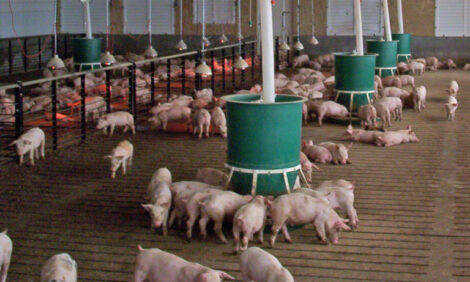



Research Sheds Light on Fat Digestibility in Pigs
Producers and feed companies add fat to swine diets to increase energy but recent research from the University of Illinois, conducted by Hans H. Stein, U of I professor in the Department of Animal Sciences, along with his team of researchers, suggests that measurements currently used for fat digestibility need to be updated."It's critical that we gain a better understanding of the energy value of fat," said Professor Stein. "If we don't know the true energy value of fat, we can't determine if it's economical to add to the diet."
In a recent experiment, Professor Stein and his research team studied how different types of diets affect endogenous losses of fat, i.e. fat excreted from pigs that did not originate from the diet. They measured endogenous losses of fat to determine the true digestibility of both intact and extracted corn oil. The intact corn oil was provided in the form of corn germ, and the extracted fat was provided as liquid corn oil.

Endogenous losses differed depending on the type of fat in the diet, he said. The intact fat was less digestible than extracted fat.
"We believe that the main reason intact fat is less digestible than extracted fat is that it is easy for the enzymes to gain access to the fat in corn oil. In contrast, the corn germ is encased in the feed ingredient among the fiber complexes, which makes it difficult for enzymes to access and digest it," Professor Stein said.
His team also discovered that measuring fat digestibility at the end of the ileum results in a more accurate value than measuring the total tract digestibility of fat.
"The microbes in the hindgut can synthesise fat," Professor Stein explained. "This fat is not absorbed in the hindgut; it's just excreted in the faeces. Because of this, it's easy to underestimate the amount of fat that was absorbed in the small intestine by the pig."
Professor Stein said this research has opened new doors for swine nutrition.
"We knew that the concentration of fat in the diet affects the value that is determined for apparent digestibility," Professor Stein said. "However, by correcting these values for the endogenous losses, we can calculate the true digestibility of fat fed to pigs."
Results of the research indicate that more information on fat digestibility is needed to ensure that diets are formulated economically.
"We now know that fat digestibility should be determined as ileal digestibility rather than total tract digestibility to avoid the influence of the microbes in the hindgut of pigs," he said. "We also know that for practical feed formulation, it is more accurate to use values for true ileal digestibility than for apparent ileal digestibility because these values are not influenced by the level of fat in the diet."
However, Professor Stein said we still do not know many of the factors that influence fat digestibility in different feed ingredients and we do not have good data for the true ileal digestibility of fat in most of our feed ingredients. A better understanding of how fat is utilised by the pig after absorption is also needed. He believes follow-up research should focus on addressing these questions and determining the energy value of the different sources of fat used in swine diets.
‘Effect of the form of dietary fat and the concentration of dietary neutral detergent fiber on ileal and total tract endogenous losses and apparent and true digestibility of fat by growing pigs,’ was recently published in the Journal of Animal Science. Researchers include D.Y. Kil, T.E. Sauber, D.B. Jones and H.H. Stein.
March 2011








